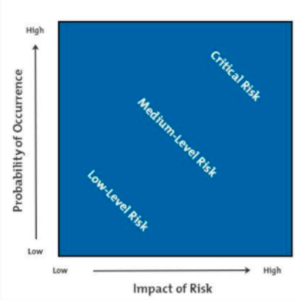GUEST AUTHOR: Dennis Freeman, Risk Mitigation Director at Freeman Enterprises
I don’t know about you, but I’m ready to get back to event work. I’m ready to start building budgets, creating timelines, talking to vendors and getting back out on the event site! As we start to plan for that blessed day, there are new details and concerns to ponder. Assessing risk and putting practical guidance into place is always a necessary component to responsible event planning. With the addition of COVID-19, these plans have moved from important to vital for the health, safety and well-being of your patrons and staff. Working through a detailed Risk Analysis and Risk Mitigation plan could mean the difference between success and failure.
What Is Risk Analysis?
Risk Analysis is a process that helps you identify and manage potential problems that could undermine the success of your event. To carry out a Risk Analysis, you must first identify the possible threats that you face, and then estimate the likelihood that these threats will materialize. Risk Analysis can be complex, as you’ll need to draw on detailed information such as local health department rules and regulations, security protocols, cleaning and sanitizing protocol, etc.
Start with an Impact Analysis
This technique is a useful brainstorming exercise that helps you identify potential risks and think through the full impact of each risk. This practice also sets the stage for creating and implementing a Risk Mitigation plan.
1. Prepare
The first step is to gather the players; key staff, important sub-contractors, board members, etc. Make sure everyone understands the parameters of the analysis and the intended goal.
2. Brainstorm Major Areas of Concern
Consider and notate all areas that would be considered unsafe or need to be adjusted/modified in order to become safer. Consider each step of the patron experience as well as the back of house areas. At this point, just focus on problem areas, not solutions. Stick to “big picture” areas during this step.
3. Dig Deeper
For each area identified during step #2, begin to tease out details. At this point, get as granular as necessary in order to create a detailed, deep dive look at all areas of concern.
4. “What If” Analysis
In this portion of the exercise, you ask a series of “what if” questions to further research potential areas of impact. Take each element of the risk list you created in Steps #2 and #3 and begin to ask, “What If this happens?”, “What if that happens?”. Make sure to keep a detailed list of each scenario for use during Section 4 of this process.
Develop a Risk Impact/Probability Chart
Now that you and your team have created a detailed list of concerns, the next step will be to prioritize those risks. If you do this effectively, you can focus the majority of your time and effort on the most important risks. The Risk Impact/Probability Chart provides a useful framework that helps you decide which risks need your attention.
The Risk Impact/Probability Chart is based on the principle that a risk has two primary dimensions:
1) Impact – A risk, by its very nature, always has a negative impact. However, the size of the impact varies in terms of cost and impact on health, human life, or some other critical factor.
2) Probability – A risk is an event that “may” occur. The probability of it occurring can range anywhere from just above 0 percent to just below 100 percent. (Note: It can’t be exactly 100 percent, because then it would be a certainty, not a risk. And it can’t be exactly 0 percent, or it wouldn’t be a risk.)
The chart allows you to rate potential risks on these two dimensions. The probability that a risk will occur is represented on one axis of the chart – and the impact of the risk, if it occurs, on the other.
You use these two measures to plot each risk on the chart. This gives you a quick, clear view of the priority that you need to give to each risk. You can then decide what resources you will allocate to managing that particular risk.
Below is a basic form of the Risk Impact/Probability Chart.

The corners of the chart have these characteristics:
- Low impact/low probability – Risks in the bottom left corner are low level, and you can often ignore them.
- Low impact/high probability – Risks in the top left corner are of moderate importance – if these things happen, you can cope with them and move on. However, you should try to reduce the likelihood that they’ll occur.
- High impact/low probability – Risks in the bottom right corner are of high importance if they do occur, but they’re very unlikely to happen.
- High impact/high probability – Risks towards the top right corner are of critical importance. These are your top priorities and are risks that you must pay close attention to.
For most live events, you also need to look closely at high impact/low probability risks that could result in injury or loss of human life. There are far too many recent examples of events where low probability risks became high impact realities.
Build your Risk Mitigation Plan
Once you’ve identified the value of the risks you face, you can start to look at ways of managing them.
Avoid the Risk
In some cases, you may want to avoid the risk altogether. This could mean postponing or cancelling your event. This is a wise option when taking the risk involves no advantage to your organization, or when the cost of addressing the effects is not worthwhile, the negatives far outweigh the positives.
Share the Risk
While this may be an option for risks unrelated to COVID-19, it will more than likely not be viable under those conditions. An example of when this might make sense would be related to financial risk. Rather than charge a food vendor a flat fee for his booth space, share the risk by offering vendors a percentage deal. In this situation, both you and the vendor share the risk but also share the spoils.
Control the Risk
This is your key area of concern and where you should spend the majority of your time and effort. Work with your team as well as local officials to strategize how to control or at least minimize the impact of each risk that can’t be avoided or is too risky to accept. From your Impact/Probability chart, these risks would be those in the high impact/high probability zone. However, especially during these times, it is wise to work through this process for the high impact/low probability risks as well.
Controlling risk during the time of COVID-19 will require diligent research and study in order to understand the probability of each risk, as well as keeping up with the latest scientific guidelines and government recommendations for having safe mass gatherings.
Accept the Risk
This option is reserved for situations when the potential impact of a risk is less than the cost of insuring against the risk, or when the potential gain is worth accepting the risk. These risks would fall in the Low impact/low probability zone.
Work with your Local Authorities
Under “normal” circumstances, working with local authorities can be as simple as completing permit applications and fulfilling the usual permit requirements. Now with COVID-19 added to the equation, relationships with local authorities will be vital to the success of your event. Not only will local authorities decide if and when it is safe to hold any sort of mass gathering, they will also expect you to provide a detailed health and safety plan before approving your event. It is more important than ever to maintain open honest communications with all local authorities and to build upon past positive relationships with those authorities.
All of the steps outlined above should be used to create a detailed health and safety plan to submit to the following entities:
- Special Event Permitting officials
- City or County Health Department
- State Health Department
- Local Law Enforcement
The Go-No Go Decision
Now that you have all the data and a plan for risk mitigation, it’s decision time. Here are a few items to consider as you work through the decision-making process:
What key concerns were highlighted by your Risk Analysis? Do you have a plan for mitigating those risks?
What are the costs (financial and otherwise) of mitigating those risks?
Are there risks that aren’t worth the cost? Deal Breakers (for example, __% of new cases due to your event)
If the risks can be mitigated or minimized to the point of having very low impact, are there any other factors that would impact your decision to go – no go? Ethics, morality, local authorities, negative impact on other shareholders (board, funders, etc.)
Conclusion
A decision to move forward with your event should hinge on confidence that the plans and procedures put in place through the risk mitigation process will:
- Maintain the health of staff, vendors, artists
- Maintain the health of patrons
- Not have a negative financial impact on your event (or the future of your event)
- Not negatively impact your relationships with local authorities, sponsors, etc.
- Not negatively impact the reputation of your event


